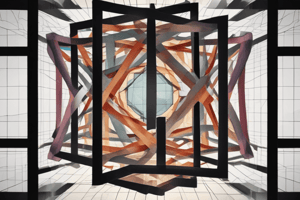Podcast
Questions and Answers
Who secretly solved the cubic equation in the early 16th century?
Who secretly solved the cubic equation in the early 16th century?
- Raffaelle Bombelli
- Luca Pacioli
- Scipione del Ferro (correct)
- François Viète
Who challenged Nicolo Fontana Tartaglia and later revealed the solution to the cubic equation?
Who challenged Nicolo Fontana Tartaglia and later revealed the solution to the cubic equation?
- Luca Pacioli
- Gerolamo Cardano
- Antonio Fior (correct)
- Raffaelle Bombelli
Which mathematician introduced complex numbers to deal with the roots of negative numbers?
Which mathematician introduced complex numbers to deal with the roots of negative numbers?
- François Viète
- Raffaelle Bombelli (correct)
- Scipione del Ferro
- René Descartes
Who developed an algorithm for solving cubic equations presented as a poem?
Who developed an algorithm for solving cubic equations presented as a poem?
Which mathematician published the work 'Ars Magna' in 1545, including a geometric proof for solving cubic equations?
Which mathematician published the work 'Ars Magna' in 1545, including a geometric proof for solving cubic equations?
Who introduced modern algebraic notation in the 17th century?
Who introduced modern algebraic notation in the 17th century?
Study Notes
- Mathematics started as a way to quantify and measure the world, predict planetary movement, and record trade.
- Luca Pacioli published "Summa de arithmetica" in 1494, containing a section on the cubic equation which had puzzled mathematicians for over 4,000 years.
- The solution to the cubic equation was deemed impossible due to ancient mathematicians' reluctance to accept negative numbers or solutions.
- Scipione del Ferro secretly solved the cubic equation in the early 16th century, passing his method to his disciple Antonio Fior.
- Fior later challenged Nicolo Fontana Tartaglia, who quickly solved all 30 cubic equations presented to him, leading to the revelation of the solution to the cubic equation.
- Tartaglia developed an algorithm for solving cubic equations, presented as a poem, and became a mathematical celebrity.
- Gerolamo Cardano convinced Tartaglia to reveal his method, leading to Cardano's publication of "Ars Magna" in 1545, which included a geometric proof for solving cubic equations.
- Raffaelle Bombelli later introduced complex numbers to deal with the roots of negative numbers that arose in solving cubic equations.
- François Viète introduced modern algebraic notation in the 17th century, ending the era of geometric problems in mathematics.
- René Descartes popularized imaginary numbers, leading to the development of complex numbers used in modern physics, notably in Schrödinger's wave equation.
- Schrödinger's wave equation, with the involvement of the square root of -1, revolutionized quantum mechanics by accurately describing atomic behavior.
- The use of complex numbers in mathematics and physics, particularly in Schrödinger's equation, highlighted the power and necessity of these numbers in understanding the universe.
Studying That Suits You
Use AI to generate personalized quizzes and flashcards to suit your learning preferences.
Description
Explore the historical journey of solving cubic equations from ancient times to the introduction of complex numbers by Raffaelle Bombelli. Learn about key figures like Scipione del Ferro, Nicolo Fontana Tartaglia, Gerolamo Cardano, and how the development of complex numbers revolutionized mathematics and physics.




